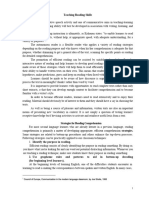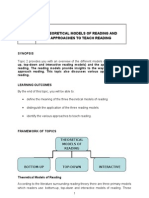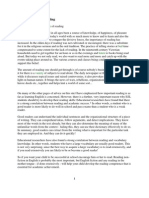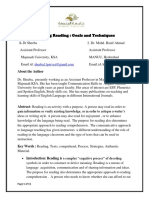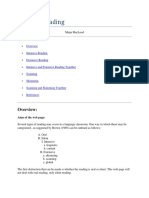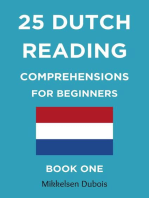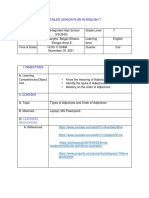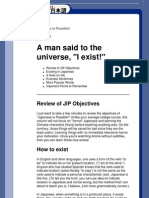Teaching_reading_and_writing
Teaching_reading_and_writing
Uploaded by
Rawan JaladCopyright:
Available Formats
Teaching_reading_and_writing
Teaching_reading_and_writing
Uploaded by
Rawan JaladCopyright
Available Formats
Share this document
Did you find this document useful?
Is this content inappropriate?
Copyright:
Available Formats
Teaching_reading_and_writing
Teaching_reading_and_writing
Uploaded by
Rawan JaladCopyright:
Available Formats
Teaching reading and writing
Título: Teaching reading and writing. Target: Bachillerato, Profesorado de Lengua Inglesa, alumnos de Magisterio
(especialidad Inglés) o Filología Inglesa. Asignatura/s: Inglés. Autor/a/es: Eva María Gordo Rojas. Licenciada en
Filología Inglesa.
T eaching a foreign language implies a conscious activity. This activity is intended to result in
personal learning for students. The procedure of learning a foreign language implies four main
skills that are listening, speaking, reading and writing.
If we take into account the historical perspective at the beginning, teaching a foreign language was
based on grammar and translation, so reading and writing were the major focus. Then speaking and
listening took place and became one of the main goals of teaching.
Nowadays, the four skills are important to learn a foreign language as it is English. Taking into
account this modern point of view I am going to base my research paper on reading and writing skills
as a part of teaching English.
Reading is to be able to work out the meaning of a written text. What is on the page and what is on
the mind Clarke and Silberstein (1977: 136-7) established “…Readers understand what they read
because they are able to take the stimulus beyond its graphic representation and assign it
membership to an appropriate group of concepts already stored in their memories…Skill in reading
depends on the efficient interaction between linguistic knowledge and knowledge of the world.”
Writing is to communicate a message writing it down on a piece of paper. That is to say putting
ideas down on a paper transform thoughts into words giving them structure and coherence. Peter
Elbow (1973:14-16) expressed his concept of writing in this way: “Writing is a two-step process. First
you figure out your meaning, then you put into language: …figure out what you want to say; don’t
start writing till you do; make a plan; use an outline; begin writing only afterward.”
READING SKILL
Types of reading
Reading is a process that concerns an interaction between what is in our mind and the way in which
we express those thoughts. This process is different depends on the circumstance by we are reading a
book, a magazine, a newspaper, and so on. For that reason reading a text can be classified taking into
account two categories:
a) Intensive. This occurs when you read short texts in detail in the classroom, for getting
information.
b) Extensive. It refers to reading longer texts outside the classroom, for pleasure.
PublicacionesDidacticas.com | Nº 2 Diciembre 2009
234 de 383
In this way, a student can read a poem or a novel intensive or extensively. Intensive reading, if
the pupil reads the novel for a task in class. Extensively, he/she reads it in his/her leisure.
Micro skills for reading comprehension
There are several points to take into account for getting a perfect reading, that is to say, to
understand perfectly a text:
1. Discriminate among graphemes ahs orthographic patterns of English.
2. Retain chunks of language of different lengths in memory.
3. Process writing at an efficient rate of sped to suit the purpose.
4. Recognize a focus of words and interpret word order.
5. Recognize grammatical patterns, rules, and word classes.
6. Recognize a particular meaning.
7. Recognize cohesive elements.
8. Recognize rhetorical forms and their interpretation.
9. Infer context (events, causes, relations, new and given information)
10. Distinguish between literal and non-literal meaning.
11. Develop and use reading strategies.
Strategies
Reading comprehension is a fundamental matter for learners of a second language. This becomes
efficient if the learners follow the comprehension strategies. Some of these strategies are related to
the procedures involved in listening skill. On the one hand, bottom-up procedures in which learners
listen to stream of sounds and they have to segment the stream of sounds and recognize boundaries,
and on the other hand, top-down procedures in which learners create expectations about the person
is going to say, and once learners have created these expectations, they define or modify these ideas.
These are the main strategies that can be applied to the techniques of the classroom:
1. Word-attack skills: deducing the meaning of unknown words from context without looking them
up in the dictionary.
a) Using context clues: using synonyms and antonyms in the same sentence or paragraph.
PublicacionesDidacticas.com | Nº 2 Diciembre 2009
235 de 383
b) Using structural information: this refers to word formation, an analysis of stems and affixes
of words can help to get the meaning of unfamiliar words.
2. Reading in meaningful units: students should be able to read in meaningful units instead of
isolated words. A useful way to teach this skill is to break up a sentence into sense groups and have
students focus their eyes on the middle of each sentence group. Good readers have to read in chunks.
3. Scanning: using to locate specific information such a date, a figure, or a name. The key is to
decide what kind of information we are looking for and where to find it. A useful way to teach this skill
is to have students search for some specific information.
4. Skimming: we try to get the general idea of the whole text. The key of skimming is to know
where to find the main ideas of different paragraphs, and to be able to synthesize them. One effective
technique to teach skimming is to read the first and the last paragraph in full, and the first and last
sentence of the paragraph in between and pick up the key words.
5. Prediction: making correct predictions with minimal sampling. Students can learn to make
predictions based on the title, subtitle, and their knowledge of the topic.
6. Recognizing organizational patterns: taking into account text and discourse. The most common
patterns are cause-effect, sequence of events, special geographic, descriptions. These patterns are
linked by textual connectors. To teach this strategy students can read different passages with
different organizational patterns ad identify their textual connectors.
7. Distinguishing general statements from specific details: general statements contain main ideas,
and specific details are explanations and examples that support the general statements. So general
are more important than specific. Students should learn to direct their attention to signal like in
general, above all, in conclusion and I can be seen that.
8. Inference and conclusion: comprehension involves explicit and implicit understanding. So readers
have to make inferences base on what is stated. Conclusion is based on putting stated facts together
of what is implied from what is stated. In short, to infer is that the reader has to read between lines
and to conclude is that he/she has to summarize stated facts.
9. Evaluation and appreciation: the reader has to understand, analyze, and synthesize to form
his/her own opinion. To evaluate the students has to be critical and determine the author’s purpose.
To appreciate the reader has to understand the author’s tone and attitude and to recognize his
literary devices.
Reading performance
Performing a reading classroom depends on the variety of texts. We can ask to student to read
orally at the beginning and intermediate levels. In this way, oral reading can be:
a) An evaluative check on bottom-up processing skill
PublicacionesDidacticas.com | Nº 2 Diciembre 2009
236 de 383
b) A pronunciation check
c) An extra student participation
At advanced level, we use oral reading to serve these three purposes because the disadvantages:
a) It is not a very authentic activity
b) Students lose attention
c) It is mere recitation
Silent reading can be classified into intensive and extensive. Intensive in the sense that is a
classroom oriented activity focused on linguistic or semantic details of the passage. Students have to
pay attention on grammatical forms, discourse makers, and structures with the purpose of
understanding literal meaning. Extensive because is has to achieve a general understanding of a text.
In this sense, all pleasure reading is extensive.
Reading techniques
One important point is to have time for extensive reading. Silent reading provides a sense of
fluency among students. This type of reading is like a method of self-instruction on the learner.
What students need is the focus to look for a text. Reading must be interesting and relevant, that is
to say, reading must motivate the learners. For that reason we have to concentrate on what are their
needs. One motivating approach is Language Experience Approach. The basis of this approach lies in
student’s self-generation of reading material. They create their own textbook, for example divided
into groups they can create a story or a dictionary. This method provides a different way of learning.
It is important that the student works with authentic language and context in a simple way. Most of
times, the original texts are simplified. We have to take into account the difference between simple
text and simplified texts. A simple text is that are authentic but grammatically and lexically simple.
While a simplified text is that removes natural redundancy that become difficult.
We have to support the use of reading strategies.
To give enough time in classroom so students can apply bottom-up and top-down procedures.
Reading techniques are divided into three main stages:
a) Pre-reading: introducing a topic so learners encourage skimming and scanning. Students bring
their knowledge to the text.
b) While-reading: students can take notes while they are reading. This provides a sense of purpose.
c) Post-reading: comprehension questions considering vocabulary, author’s purpose, and
grammatical structures.
PublicacionesDidacticas.com | Nº 2 Diciembre 2009
237 de 383
Finally, we can observe if the student has comprehended a text if:
- The reader responds to the command doing
- The reader selects from alternatives the best one choosing
- The reader summarizes what is read transferring
- The reader answer questions about the text answering
- The reader takes notes on the text condensing
- The reader provides an ending of the text extending
- The reader translates into the mother tongue duplicating
- The reader engages in a conversation indicating appropriate process of information conversing
What can we do with a text?
When we want to analyses and get a full comprehension a text of whatever kind (a novel, a piece of
advertisement, a poem, a letter, a message, an essay, or what you want) we have to follow several
steps to understand it correctly. These instructions are principally four which, at the same time, are
divided into smaller items.
1. Pre-text
- Prediction:
- from first/last lines
- title
- key words
- visuals
- Guiding questions
- Discussion on the topic (from a related activity)
- Brainstorming related vocabulary
2. Comprehension
- Checking predictions
- Inventing a title
PublicacionesDidacticas.com | Nº 2 Diciembre 2009
238 de 383
- Reordering
- Unjumbling texts in different styles
- Writing questions on the text
- Matching titles, visual, topic sentences to paragraphs
- Transferring and transforming
- Correcting a summary/selecting the best
- Comparing and contrasting texts
- Interrupting, predicting, completing
- True/false statements/open questions/gap fill/sentence
- Summary completion
- Understanding the communicative function or value
3. Language
- Awareness raising/analysis of grammar
- Pronunciation work
- Text cohesion devices
- Understanding the organizational patterns of the text (coherence)
- Deducing words in context
- Word formation
- Vocabulary awareness (synonyms, hyponyms, and collocations)
- Dictionary work
- Inference/style/connotation
- Matching words with paraphrases
4. Performing and responding
- Discussion, debate, planning
- Role play. Simulation
PublicacionesDidacticas.com | Nº 2 Diciembre 2009
239 de 383
- News broadcast/radio programmes
- Quizzes/questionnaires
- Telling stories
- Interviews
- Jigsaw activities/information gap
- Writing from models
- Process writing (letters, diaries)
- Creative writing (stories, poems, plays)
Activities
In this section, I have selected a text about the history of basketball. Then I have proposed several
activities to work with the text.
THE DAY BASKETBALL WAS INVENTED
One winter’s day in 1891, a class at Young Men’s Christian Association Training School in Springfield,
Massachusetts, USA, went into the gym for their daily exercises. Since the football season had ended,
most of the young men felt they were in for a rather boring time.
But their teacher, James Naismith, had other ideas. He had been working for a long time on a new
game that would have the excitement of American football, but without its danger of injury. American
football is a dangerous game to play in a gym, because someone running with the all can be caught
and pulled down to the ground. Naismith thought, “Why not play a game in which the ball has to be
caught, rather the player?”
Naismith showed the men a basket he had hung at each end of the gym and explained that they
were going to use a round European football rather than the American kind, which is oval. At first,
everyone tried to throw the ball into the basket, no matter where he was standing. “Pass, pass!”
Naismith kept shouting, blowing his whistle to stop the excited players. Slowly, they began to
understand what was wanted of them.
The problem with the new game, which was soon called “basketball”, was getting the ball out of the
basket. Because ordinary fruit baskets with bottoms were being used, the ball, of course, stayed inside.
At first, a ladder was set up near the basket, and someone had to climb up every time a basket was
scored. Another solution was that one of the players would balance on the shoulders of another player
after each score. It was several years before someone had the idea of removing the bottom of the
basket and letting fall through.
PublicacionesDidacticas.com | Nº 2 Diciembre 2009
240 de 383
There have been many changes in the rules since then. The game that was invented by James
Naismith has become one of the world’s most popular sports, played in more than 70 countries. It is
estimated that between 40 and 50 million men and women play in amateur and professional teams
each year. The number of people who watch, particularly on TV, must be hundreds of millions.
PRE-READING
1. Brainstorming of words related to basketball
2. Why do you think basketball is so popular in the world? Discussion
3. Pre-teach some vocabulary
WHILE-READING
1. Completion questions
- What’s the author’s nationality?
- Where basketball was originated?
- Where was it was played in USA?
2. Deduce from context those words which you don’t know
daily injury balance
whistle season no matter
3. True or false statements
- Naismith developed a game that was both exciting and safe
- It’s quite harmless to play American football in a gym
- In Naismith’s new game, the players had to catch each other.
- American and European footballs are shaped differently
- Basketball is still played in the same way as it was in 1891
POST-READING
PublicacionesDidacticas.com | Nº 2 Diciembre 2009
241 de 383
1. Make a summary of the main ideas of the text
2. Role play: recreate a situation/conversation playing in the gym
3. Discussion: what’s the importance of basketball in USA culture?
WRITING SKILL
Types of written language
Reading skill is closed to writing one. For this reason, we have to take into account the several types
of written text that we can find. There are a lot of kinds of written text. Each of these kinds represents
a genre of written language. If a pupil distinguishes the genre of the text that you are reading, he/she
can know the purpose of his/her reading. For that reason, it is very important to identify the text. As a
teacher, we must learn to the student differences among a novel, an advertisement or an article of a
newspaper. In this way, there is an established list corresponding the following:
Non-fiction:
Reports
Editorial
Essays
Articles
Reference: dictionary, encyclopedias
Fiction:
Novels
Short stories
Jokes
Drama
Poetry
PublicacionesDidacticas.com | Nº 2 Diciembre 2009
242 de 383
Letters:
Personal
Business
Greeting cards
Announcements
Newspaper “journalese”
Academic writing
Advertisements
Recipes
Directories
Characteristic of written language
1. Permanence: Students feel not very pleasant when they have to give their work to the
teacher. They fear about it is not written correctly. For this reason, as teacher, we must guide and
revise their work before the final writing.
2. Production time: Students must write their work in limited time since this process is an
efficient factor to produce the final writing. As teacher, the goal is to establish the use of these
limitations.
3. Distance: This means that we have to take into account the empathy, that is to say, a good
writer must imagine or read mentally what the audience is going to read. For that reason, the writer
has to select the language and how it is going to be interpreted.
4. Orthography: We have to pay attention about our non-literate and literate students. In that
way, for non-literate we have to begin from the very beginning, for literate we have to produce new
symbols by hands if their native language is not alphabetic, but if their native language has a different
phoneme system, we have to pay a lot of attention in order to explain new phonemes correctly.
5. Complexity: Here, students must know to combine sentences, make differences between
elements, create lexical variety, and so on.
6. Vocabulary: Students have to take into account the English vocabulary which is very rich.
PublicacionesDidacticas.com | Nº 2 Diciembre 2009
243 de 383
7. Formality: Students have to learn how to describe, explain, compare, contrast, criticize, and
argue.
Micro-skills for writing skill
We have to encourage several abilities to produce a writing work properly. These aptitudes are:
1. Produce orthographic patterns of English
2. Produce writing in a limited time to fit the purpose
3. Use appropriate word order and a core of words
4. Use grammatical systems and rules
5. Apply different grammatical forms for the same meaning
6. Use cohesive elements
7. Use coherence elements
8. Difference between literal and non-literal meanings
9. Develop and use writing strategies
Writing performance
Writing is a skill which its performance is very limited. In this sense, writing performance has five
categories:
1. Imitative or, writing down: One method is dictation in which students con learn the order
processing. This method involves several steps:
a) Teacher reads a paragraph once or twice at normal speed
b) teacher reads small phrase units(3 or 4 words) followed by a pause each one.
c) Students write what they hear
d) Teacher reads the whole paragraph at normal speed, and students check their writing
e) Scoring of students’ written work
2. Intensive or, controlled: a way of controlled writing is to give a paragraph to students in which
they have to change the given structure. Another form is dicto-comp, a paragraph is read at normal
speed, then teacher puts key words on the board and ask students to rewrite the paragraph.
PublicacionesDidacticas.com | Nº 2 Diciembre 2009
244 de 383
3. Self-writing: students write their experiences, feelings, or what they want in a journal.
4. Display writing: the diary exercises (examinations, answers) make on class are elements of
display for students.
5. Real writing: there is a link between real writing and display. This reality is injected into display,
so there are three subcategories:
a) Academic: students exchange information with each other and the instructor.
b) Vocational/technical: students can be improved writing through advancement in their
occupation, such as real letter.
c) Personal: through personal letters, diaries, post cards, and so on.
Writing techniques
It is important to know some of the main goals of the good writers:
- focus on an idea in writing
- planning what write
- take the first ideas onto the paper
- follow an organizational plan to write
- utilize feedback to write
- revise the work
We have to take into account the English rhetorical conventions and explain them to the students.
It is important reading to be able to write a composition, so we must to encourage reading of any
kind of text in order to achieve the core of vocabulary of the topic.
Writing must be as authentic as possible in order to be clear for students.
There are three stages of processes writing: prewriting, drafting, and revising stages. Prewriting
encourages the generation of ideas by reading, skimming or scanning, discussing a topic, or listening.
The drafting and revising stages are the core of process writing by getting started, read aloud, or using
the instructor’s feedback.
Interaction must be presented in writing in form of group collaboration, or critiquing.
PublicacionesDidacticas.com | Nº 2 Diciembre 2009
245 de 383
Giving the features for English rhetorical, formal, conventions of writing. That’s to say, devices
used to explain, propose, debate, and argue.
Evaluating a student is a process in which we must judge with explicitness in what we consider
relevant aspect to write correctly. For that reason in the evaluation of a student written composition,
we must take into account the following points:
Content:
Related ideas
Use of description, cause/effect, comparison/contrast
Development of ideas
Organization:
Introduction
Middle: sequence of ideas
Conclusion
Discourse:
Topic sentences
Paragraph unity
Discourse markers
Cohesion
Reference
Fluency
Variety
Syntax
Vocabulary
Mechanics:
Punctuation
PublicacionesDidacticas.com | Nº 2 Diciembre 2009
246 de 383
Spelling
Activities
Then I am going to propose some activities in order to develop some of the principal steps to
write a composition. These exercises must be done after the proper explanation about the topic.
CONNECTING IDEAS
1. Complete the following sentences using the suitable expression from the list.
Both…and in addition either…or neither…nor so/and so
Not only…but also for one thing whereas yet and/or
a. What do you want to do this weekend? We can ……. go to the beach … go to the mountain.
b. We arranged catering for the occasion. ….., we have hire a band to play.
c. ….., I haven’t time to talk now. …..I’m not prepared to discuss this with you.
d. Smoking is ….. unhealthy, …. dangerous.
e. …… July …. Tom are invited to the prize-giving ceremony at the end of the school.
f. Ian didn’t get high marks, ….. he was accepted to university.
g. You’ll need paints, blue ….. yellow to make posters to advertise the event.
h. Susan speaks fluent Italian, …… shelly doesn’t understand a word of it.
i. We have ……space ….. time to put on a full-length play at school.
SUBORDINATE CLAUSES
1. Read the following paragraph and answer the questions below.
Sir Arthur Conan Doyley was the man who created the fictional character Sherlock Holmes. Doyley
was born in 1859 in Edinburgh, Scotland, where he studied medicine. Being a poor student, he was
forced to start writing stories in order to support himself. In 1887, when he was 28, his first was
PublicacionesDidacticas.com | Nº 2 Diciembre 2009
247 de 383
published. It was in this book that Sherlock Holmes, the detective and his friend, Dr. Watson,
appeared. “Elementary, my dear Watson” is an expression which is still used today and is the
expression that Holmes is famous for. When Doyley wrote his Sherlock Holmes mysteries, he gave
Holmes an address in Baker Street, London. This was the place that became the centre of Holmes’
work. Whenever he had a crime to solve, he would meditate in his Baker Street study. When Doyley
tired of the character that he had created, he decided to kill him off. However, because these stories
had become so popular, he was forced to bring back the character whose skill as a detective had
become almost legendary. Doyley continued writing and while he was serving as a doctor in the Boer
War, he wrote an article on that war, which earned him a knighthood. He died in Sussex, England, in
1930.
a. Identify the subordinate clauses in the passage.
b. List the words which introduce them.
c. Choose four different types of clause and explain what they are.
d. Find two examples of clauses which need commas. Explain.
ORGANIZING A PARAGRAPH
1. Read the following paragraph and answer the questions below
Tourism on a large scale is causing serious damage to the Mediterranean Sea and its coastline.
Crows of tourist often leave behind large amounts of litter, such as paper, bottles and cans, on the
beach of Italy, Greece and Spain. Furthermore there has been an increase in the number of yachts and
tour cruises off the coasts and they are causing damage to marine life in these areas. Many yacht
owners dump their rubbish and sewage directly into the coastal water. This increase in the number of
boats has led to the building of marinas all over the Mediterranean. The litter, noise overcrowding and
pollution in these marinas are destroying the fragile ecology of the Mediterranean waters, and, as a
result, there are more dead birds, fish and marine mammals than ever before. In fact these tourists are
gradually destroying the very coastal resorts they want to visit.
a. Can you identify the topic sentence?
b. How many supporting ideas are there?
c. Can you identify the concluding sentence? How does it compare to the topic sentence?
d. Which words were used to link ideas together and maintain unity and coherence?
ARGUMENTATIVE WRITING
PublicacionesDidacticas.com | Nº 2 Diciembre 2009
248 de 383
1. Join the following pairs of sentences together using a suitable expression of comparison or
contrast
a. The area of Greece includes many islands. The area of Spain includes several islands.
b. Robots can work 24 hours a day. People need to eat and rest.
c. England has along democratic tradition. Israel is a young democracy.
d. There are many types of entertainment in a city. Such entertainment is often quite expensive.
e. England suffered a civil war. Spin had a civil war.
Bibliografía
Barnett, Marva (1989) More than Meets the Eye: Foreign Language Reading Theory in Practice. Prentice Hall
Brown, H.D. (1994) Teaching by Principles. Prentice Hall International.
Genesee, F. & Upshur (1996) Classroom-Based Evaluation in Second Language Education. Cambridge University
Press.
Grabe, William (1991) “Current Developments in Second Language Reading Research”, TESOL Quarterly
Kroll, Barbara (1990) Second Language Writing: Research Insights for Classroom. Cambridge University Press.
Rowan, J. , Miles, P. & Montera Gil, E. (1993) The Burlington course for C.O.U. and Selectividad. Burlington Books
El idealismo modal, con objeciones del realismo
modal
Título: El idealismo modal, con objeciones del realismo modal. Target: 1º y 2º de Bachillerato de Humanidades y
Ciencias Sociales. Asignatura/s: Historia de la Filosofía. Autor/a/es: Esteban Galisteo Gámez, Licenciado en Filosofía y
Máster en filosofía contemporánea.
A continuación presentaremos algunas tesis sobre la metafísica de Leibniz. Llamaremos a esta
concepción idealismo modal, debido fundamentalmente a dos razones: 1) en primer lugar se
basa en un punto realista sobre las ideas. Más adelante diremos más sobre esto. En segundo
lugar, 2) toma como nociones básicas las nociones modales de necesidad y posibilidad.
Contrapondremos el idealismo modal de Leibniz al realismo modal de David K. Lewis, planteando
objeciones desde el segundo al primero.
PublicacionesDidacticas.com | Nº 2 Diciembre 2009
249 de 383
You might also like
- Receptive Skills: Reading Task 1Document6 pagesReceptive Skills: Reading Task 1Máté NémethNo ratings yet
- Facilitator/Learner Guide: Write/Present/Sign Texts For A Range of Communicative ContextsDocument38 pagesFacilitator/Learner Guide: Write/Present/Sign Texts For A Range of Communicative Contextsnoxolo CharityNo ratings yet
- Makalah NewDocument11 pagesMakalah NewAnida Riyanti50% (2)
- Teaching ReadingDocument5 pagesTeaching ReadingRembulan Onaa Unny100% (1)
- AEC-II-unit-3Document7 pagesAEC-II-unit-3rupal785785No ratings yet
- English Language Teaching Unit 02Document14 pagesEnglish Language Teaching Unit 02William SkamNo ratings yet
- Chapter I1Document25 pagesChapter I1umiNo ratings yet
- Document PentingDocument10 pagesDocument PentingYeci GuraNo ratings yet
- Teaching ReadingDocument12 pagesTeaching ReadingDado Dodo100% (1)
- Hard Copy ETMDocument5 pagesHard Copy ETManis thahirahNo ratings yet
- Council of Europe, Communication in The Modern Language Classroom, by Joe Sheils, 1993Document11 pagesCouncil of Europe, Communication in The Modern Language Classroom, by Joe Sheils, 1993marivoskanyan63No ratings yet
- Extensive Reading DoneDocument7 pagesExtensive Reading Donesuci apriliana pertiwiNo ratings yet
- Teaching ProseDocument6 pagesTeaching ProseLovely VinishNo ratings yet
- Reading Workshop-Student's HandoutDocument14 pagesReading Workshop-Student's HandoutileanamoramarinNo ratings yet
- How Do You Teach Reading ComprehensionDocument10 pagesHow Do You Teach Reading ComprehensionMadz AñanoNo ratings yet
- Reading Comprehension of Grade 9 PMDocument21 pagesReading Comprehension of Grade 9 PMJohn DayaoNo ratings yet
- ReadingDocument12 pagesReadingivan.el.rey1340No ratings yet
- Types of Reading Performance - Principles For Designing Interactive Reading TechniquesDocument38 pagesTypes of Reading Performance - Principles For Designing Interactive Reading TechniquesBlaNo ratings yet
- Curriculum Desig1Document12 pagesCurriculum Desig1zebadro020No ratings yet
- Teaching Reading and WritingDocument4 pagesTeaching Reading and WritingDherick RaleighNo ratings yet
- Reading Comprehension of Grade 9 PMDocument21 pagesReading Comprehension of Grade 9 PMJohn Dayao100% (1)
- Reading SkillDocument14 pagesReading Skilljumilita aplianangongoNo ratings yet
- Chapter II AnecdoteDocument12 pagesChapter II AnecdoteApriel YaediNo ratings yet
- 1 Chapter 12 Developing Engaged L2 ReadersDocument63 pages1 Chapter 12 Developing Engaged L2 ReadersshereenNo ratings yet
- Modul Reading Topic 2 TSL 3106Document8 pagesModul Reading Topic 2 TSL 3106Rohayanti Binti YaakopNo ratings yet
- Purcom FinalsDocument26 pagesPurcom FinalsKate Fane Diaz CaliwagNo ratings yet
- Jiptummpp GDL Junaidin20 47994 3 Chapter IDocument15 pagesJiptummpp GDL Junaidin20 47994 3 Chapter IJulia nurul AkmalNo ratings yet
- Seminar of LanguageDocument34 pagesSeminar of LanguageJulia RheintanataNo ratings yet
- Naira Modul 2Document19 pagesNaira Modul 2marivoskanyan63No ratings yet
- Types of ReadingDocument5 pagesTypes of ReadingfatinfiqahNo ratings yet
- Critical Journal Book: Course Materials For Reading 1Document11 pagesCritical Journal Book: Course Materials For Reading 1ripihamdaniNo ratings yet
- Teaching Reading Comprehension by Using Intensive Reading Technique at Grade VDocument9 pagesTeaching Reading Comprehension by Using Intensive Reading Technique at Grade Vde faNo ratings yet
- Hedge T. Ch. 6 ReadingDocument9 pagesHedge T. Ch. 6 ReadingMili SoléNo ratings yet
- Reading: Literature ReviewDocument28 pagesReading: Literature ReviewRiska MahardikaNo ratings yet
- Reading and ListeningDocument8 pagesReading and ListeningKate Fane Diaz CaliwagNo ratings yet
- Reading Microskills and Procedure For Training ThemDocument11 pagesReading Microskills and Procedure For Training ThemtrinhquangcoNo ratings yet
- The Importance of ReadingDocument39 pagesThe Importance of ReadingyousufbaiNo ratings yet
- Teaching Reading-Reading StrategiesDocument2 pagesTeaching Reading-Reading StrategiessusudoNo ratings yet
- ReadingDocument17 pagesReadingjgujarityNo ratings yet
- AnswersDocument5 pagesAnswersSambad BasuNo ratings yet
- Language Teaching Appreciation: Reading Approaches and StrategiesDocument4 pagesLanguage Teaching Appreciation: Reading Approaches and StrategiesFheil Karl FailmaNo ratings yet
- Sample ReviewerDocument10 pagesSample ReviewerRalphNo ratings yet
- Types of ReadingDocument19 pagesTypes of ReadingNursyazwani HamdanNo ratings yet
- Chapter IiDocument20 pagesChapter IiMhmmd AkbarNNo ratings yet
- Teaching Reading: Goals and Techniques: Page 1 of 11Document11 pagesTeaching Reading: Goals and Techniques: Page 1 of 11adi mendrovaNo ratings yet
- Communication PptDocument19 pagesCommunication PptmgendikrNo ratings yet
- INTRODUCTIONDocument12 pagesINTRODUCTIONAstenaLargamaNo ratings yet
- Module - 3: The Purpose of ReadingDocument8 pagesModule - 3: The Purpose of ReadingShreyansh JainNo ratings yet
- Garuda 1475732Document8 pagesGaruda 1475732The CoolWolfNo ratings yet
- Teaching & Assessment of The Macro SkillsDocument7 pagesTeaching & Assessment of The Macro SkillsKrystel Mary SungaNo ratings yet
- Unit 8. Written Foreign Language. Approximation, consolidation and improvement of the reading-writing process. Reading comprehension: global and specific comprehension strategies. The writing process: from the interpretation to the production of textsDocument6 pagesUnit 8. Written Foreign Language. Approximation, consolidation and improvement of the reading-writing process. Reading comprehension: global and specific comprehension strategies. The writing process: from the interpretation to the production of textsPaloma EstebanNo ratings yet
- JELT610505Document3 pagesJELT610505asramamnoonNo ratings yet
- Lesson One General Introduction To Academic ReadingDocument6 pagesLesson One General Introduction To Academic ReadingNes Ghi NeNo ratings yet
- The Background of The StudyDocument10 pagesThe Background of The StudyMayank Aryanti Ar WhsNo ratings yet
- Bab Ii PDFDocument24 pagesBab Ii PDFNelly regina hutasoitNo ratings yet
- Types of Reading: OverviewDocument17 pagesTypes of Reading: OverviewSafaa Mohamed Abou KhozaimaNo ratings yet
- E-Reading Course DescriptionDocument7 pagesE-Reading Course DescriptionSdndcnsck SdjcnscnskNo ratings yet
- Teaching ReadingDocument11 pagesTeaching ReadingSalo Alvarado da FirenzeNo ratings yet
- 25 Dutch Reading Comprehensions for Beginners: Book One: Dutch Reading Comprehension TextsFrom Everand25 Dutch Reading Comprehensions for Beginners: Book One: Dutch Reading Comprehension TextsNo ratings yet
- Interacting with Informational Text for Close and Critical ReadingFrom EverandInteracting with Informational Text for Close and Critical ReadingNo ratings yet
- Reading for FunctionDocument8 pagesReading for FunctionRawan JaladNo ratings yet
- Pilot_PhonicsKeyLetterCardsSet_241119_001620Document246 pagesPilot_PhonicsKeyLetterCardsSet_241119_001620Rawan JaladNo ratings yet
- Alphabet for KidsDocument26 pagesAlphabet for KidsRawan JaladNo ratings yet
- easy-reading-english-book (1)Document21 pageseasy-reading-english-book (1)Rawan JaladNo ratings yet
- Vowels Sound Wall TeacherHiba_240917_105206Document1 pageVowels Sound Wall TeacherHiba_240917_105206Rawan JaladNo ratings yet
- Lesson Plan 5 EvaluationDocument4 pagesLesson Plan 5 EvaluationAmalia Si AdrianNo ratings yet
- Narrative TextDocument13 pagesNarrative TextMuhammad RezaNo ratings yet
- Quizbee LPDocument3 pagesQuizbee LPTeacher AppleNo ratings yet
- Assignment-Teaching of Reading 2024Document3 pagesAssignment-Teaching of Reading 2024ShingisNo ratings yet
- Important Questions in Methods of Teaching English of D.Ed II YearDocument3 pagesImportant Questions in Methods of Teaching English of D.Ed II YearsareenckNo ratings yet
- BS English-6th-ENGL 3125-Lecture 5Document14 pagesBS English-6th-ENGL 3125-Lecture 5abdullah kakarNo ratings yet
- ENG503 Short Notes Lesson 1-22Document14 pagesENG503 Short Notes Lesson 1-22hania noorNo ratings yet
- Tiered Assignment Planner Grade Level: 11, The Crucible Key Concepts/Skills: StandardsDocument2 pagesTiered Assignment Planner Grade Level: 11, The Crucible Key Concepts/Skills: Standardsapi-269465073No ratings yet
- Nature of Technical WritingDocument7 pagesNature of Technical WritingHsiri Enaj MiladaNo ratings yet
- Life Coaching Worksheet Module 4Document6 pagesLife Coaching Worksheet Module 4Şterbeţ RuxandraNo ratings yet
- الاختلافات الثقافيةDocument13 pagesالاختلافات الثقافيةMalak AbdullahNo ratings yet
- Unit 2 - Personal Stories - Language SummaryDocument1 pageUnit 2 - Personal Stories - Language Summarythao0505No ratings yet
- ED 107-Product-Oriented Performance Based Assessment QuizDocument4 pagesED 107-Product-Oriented Performance Based Assessment QuizKC Mae A. Acobo - CoEdNo ratings yet
- 10th English F.A - IIIDocument1 page10th English F.A - IIIAskani Kurumaiah100% (1)
- Interview EssayDocument2 pagesInterview EssayTORRES, MANELL N.No ratings yet
- Madeline Nguyen ResumeDocument1 pageMadeline Nguyen Resumeapi-666120656No ratings yet
- Designing The Reading Course: Learning OutcomeDocument22 pagesDesigning The Reading Course: Learning OutcomeEsther Ponmalar Charles100% (1)
- DLL Eapp 12 Luke March 18 - 21, 2024 VHC 24Document31 pagesDLL Eapp 12 Luke March 18 - 21, 2024 VHC 24Vanessa CabahugNo ratings yet
- Morphemes, Allomorphs and MorphsDocument21 pagesMorphemes, Allomorphs and MorphsCarla Naural-citeb100% (1)
- Detailed Lesson Plan in English 7: - Learning ResourcesDocument14 pagesDetailed Lesson Plan in English 7: - Learning ResourcesHoneylette AlquizalasNo ratings yet
- Japanese Is Possible - Lesson 08Document6 pagesJapanese Is Possible - Lesson 08Wazirah Md EsaNo ratings yet
- Academic Writing 2Document44 pagesAcademic Writing 2Gerald Rosario FerrerNo ratings yet
- Each Person Has To Sign Their Application Form. Analysis:: My FriendDocument2 pagesEach Person Has To Sign Their Application Form. Analysis:: My FriendjohnNo ratings yet
- FL1 Mod 05 Demonstratives and Possessive PronounsDocument7 pagesFL1 Mod 05 Demonstratives and Possessive PronounsJunalyn Lactawin100% (1)
- XBDBDocument1 pageXBDBNabin AdhikariNo ratings yet
- Communication and Its BarriersDocument35 pagesCommunication and Its Barriersdibyendu_mondal67% (6)
- Action Plan in Campus JournalismDocument2 pagesAction Plan in Campus JournalismJohn Elton PilarNo ratings yet
- Final Course Reflection AssignmentDocument2 pagesFinal Course Reflection AssignmentYadhukrishnaNo ratings yet
- Immersion and Sheltered Language TeachingDocument2 pagesImmersion and Sheltered Language TeachingBang YossNo ratings yet










